Stations of remembrance in Vienna's new building
The stations of remembrance in Wien-Neubau include the memorial stones in the Vienna district of Neubau , which remind of the fate of the people who were murdered, deported, expelled or driven to suicide under National Socialism. The laying is carried out by the Stones of Remembrance Association based in Leopoldstadt .
The concept of Wiener remembrance and memorial stones based on the pitfalls of Gunter Demnig and from this as plagiarism called. The memorial stones shown here differ from Demnig's stumbling blocks (a) in their size, they are four times as large, (b) in that they mostly honor several people on one memorial stone, (c) that they were made by machine and not by hand.
The table is partially sortable; the basic sorting takes place alphabetically according to the location.
List of memorial stones
The Viennese district of Neubau was and is a cultural and economic center of the city. The major shopping streets in the district are Mariahilfer Strasse and Neubaugasse , which were also an important film and cinema center in the time before Austria was annexed. In the 1930s Vienna-Neubau was home to numerous hat makers , furriers , trimmers (trimmings are trimmings for textiles), silk manufacturers and leather goods manufacturers , many of them of Jewish origin. At that time, a number of important cultural workers also lived in this district, including Karl Farkas , Egon Friedell , Fritz Hochwälder , Ruth Klüger , Fritz Kortner , Georg Kreisler , Berthold Viertel , Fred Wander and Hans Weigel . They all managed to survive the Nazi regime, admittedly in emigration or in a concentration camp .
Before 1938, the new building had a relatively high proportion of Jewish residents, around 14.8 percent. Jewish life was part of the local color and was well integrated. The most important prayer house was located at Schottenfeldgasse 60 and was used jointly by Jewish residents of the 6th and 7th district. As part of the November pogroms in 1938 , it was destroyed - like almost all Jewish prayer houses and synagogues in Vienna. Because when the National Socialists came to power in Vienna, the situation of Vienna's Jewish population had changed dramatically. They “have been deprived of their rights, dignity and property. Many of them were sent to the assembly camps at Kenyongasse 4 and 7 or in the former district court in Neubau at Burggasse 69. Within a short time they were either expelled or murdered; 950 people from the new building fell victim to the destruction. "
| image | Surname | Location | Laying date | Life | |
|---|---|---|---|---|---|
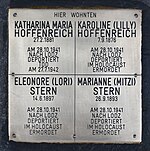
|
Katharina Maria Hoffenreich | Kandlgasse 37 |
|
Apr 29, 2013 | Katharina Maria Hoffenreich was born in Bratislava on February 27, 1881 . She lived in Vienna, most recently at Neubaugasse 25. Her name is also mentioned in the files of the Property Transaction Office, which means that her gross assets exceeded 5,000 Reichsmarks. It is also known that she was the holder of a Swiss bank account. On October 23, 1941 she was deported with Transport 8, train DA 9 (her number on the transport was 489) from Vienna (start Aspangbahnhof) to Łódź , the train reached Radegast station on October 24, 1941. On July 27th In 1942 she was murdered. |
| Karoline Hoffenreich | Karoline Hoffenreich, also called Lilly , was born on September 7, 1876. Her last known place of residence in Vienna was Neubaugasse 25/12. She was the holder of a Swiss bank account. On October 23, 1941 she was deported from Vienna to Łódź on Transport 8, train DA 9 (her number on the transport was 488) , the train reached Radegast station on October 24, 1941. She did not survive. | ||||
| Eleonore Stern | Eleonore Stern, also known as Lori , was born on June 14, 1897 in Vienna. Her parents were Siegmund Stern and Regine Stern, née Hoffenreich. She was the youngest of three children, her siblings were Pauline and Marianne Stern. She lived in Vienna, most recently at Neubaugasse 25. On October 23, 1941, she was deported with Transport 8, train DA 9 (her number on the transport was 463) from Vienna (start Aspangbahnhof) to Łódź , the train reached the station Radegast on October 24, 1941. She and her sister Marianne did not survive, nothing is known about Pauline. | ||||
| Marianne Stern | Marianne Stern, also called Mitzi , was born on September 26, 1893. Her parents were Siegmund Stern and Regine Stern, née Hoffenreich. She was the oldest of three children; her siblings were Pauline and Eleonore Stern. She lived in Vienna, most recently at Neubaugasse 25. On October 23, 1941, she was deported on Transport 8, train DA 9 (her number on the transport was 462) from Vienna (start Aspangbahnhof) to Łódź , the train reached the station Radegast on October 24, 1941. She and her sister Eleonore did not survive, nothing is known about Pauline. | ||||

|
Hudia Fiderer (nee Freud) |
Kandlgasse 44 |
|
Oct 30, 2009 | Hudia Fiderer, nee Freud, was born on March 30, 1900 in Snjatyn . She was married to Samuel Freud, their son Leo was born on March 26, 1925, their parents divorced in 1927: the father moved to Berlin, Leo stayed with his mother. Both live at Kandlgasse 44. She earned her living as a seamstress and maid for a Jewish family. When her son Leo reached school age, Hudia could not afford afternoon care, it was no longer possible to take her son to work, Hudia asked the welfare office for help: her son was sent to a Jewish orphanage for boys. Here she was only allowed to visit her son every two weeks and take him with her to go out once a month. After Austria's annexation in 1938, another family was quartered in the small apartment (10 square meters); three of them now lived here. At the beginning of 1939 Hudia Fiderer had the opportunity to flee to England to work as a maid there, she could not have taken her son with her, so she stayed in Vienna to look for a way to save her son. At that time, two of Hudia's siblings were already living in Palestine and in 1940 Leo was rescued on a children's transport that passed through Italy. There was no longer any way for Hudia to flee. On October 15, 1941, she was deported from Vienna to Łódź on Transport 6, train Da 1 (her number on the transport was 766) , the train reached Radegast station on October 16, 1941. According to her son, she was at some point in the year Deported further in 1942, where to would be unknown. Most of the people on this transport were murdered between May 4th and 5th, 1942 in the Chelmno extermination camp . Leo Fiderer eventually emigrated to the USA. |
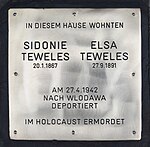
|
Elsa Teweles | Lindengasse 43 |
|
Jun 3, 2014 | Elsa Teweles was born on September 27, 1891. In Vienna she last lived in a collective flat for Jews in the 2nd district of Vienna, Rembrandtstrasse 22, together with her mother Sidonie Teweles. On April 27, 1942, she was deported from Vienna to Wlodawa on transport 18 (her number on the transport was 811) . On April 29, 1942 at 11 p.m. the train arrived at the station, from here people had to walk six kilometers to the city, from where they were transported to nearby ghettos and camps. Between June and October 1942, the people deported on this transport were murdered in Sobibor and in the Belzec extermination camp . |
| Sidonie Teweles (née Löw) |
Sidonie Teweles, nee Löw, was born on January 20, 1867 in Frýdek-Místek . She was married to Richard Teweles, the couple had a daughter - Elsa, born on September 27, 1891. Richard Teweles died on May 28, 1932 in Salzburg. In Vienna she last lived in a collective flat for Jews in Vienna's 2nd district, Rembrandtstrasse 22, together with her daughter Elsa Teweles. On April 27, 1942, she was deported from Vienna to Wlodawa on Transport 18 (her number on the transport was 812) . On April 29, 1942 at 11 p.m. the train arrived at the station, from here people had to walk six kilometers to the city, from where they were transported to nearby ghettos and camps. Between June and October 1942, the people deported on this transport were murdered in Sobibor and in the Belzec extermination camp . | ||||
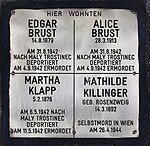
|
Alice Brust (born?) |
Myrthengasse 5 |
|
Jun 3, 2014 | Alice Brust was born in Vienna on March 28, 1913. In Vienna, she last lived at Josefinengasse 4 in Vienna's 2nd district. On August 31, 1942 she was deported from Vienna to Maly Trostinec on Transport 39, Zug Da 225 (her number on the transport was 310). the train reached its destination on September 4, 1942. The passengers were led into the forest, most of them were shot here, including Alice Brust. |
| Edgar chest | Edgar Brust was born in Vienna on August 14, 1879. In Vienna he was most recently resident at Josefinengasse 4 in the 2nd district of Vienna. On August 31, 1942 he was deported from Vienna to Maly Trostinec with Transport 39, Zug Da 225 (her number on the transport was 309). the train reached its destination on September 4, 1942. The passengers were led into the forest, most of them were shot here, including Edgar Brust. | ||||
| Mathilde Killinger (née Rosenzweig) |
Mathilde Killinger, née Rosenzweig, was born on March 14, 1892. In Vienna she last lived at 5 Myrthengasse. She committed suicide on April 26, 1944. | ||||
| Martha Klapp | Martha Klapp was born on February 5, 1876. In Vienna she last lived at 5 Myrthengasse. On May 6, 1942, she was deported from Vienna Aspangbahnhof on transport 19. Train DA 201 to Maly Trostinec (her number on the transport was 264). On May 11, 1942, the train arrived in Minsk, eight people died on the journey, 82 young men were sorted out for labor services, over 900 people were driven to a forest 13 km away and shot there, including Marta Klapp. | ||||
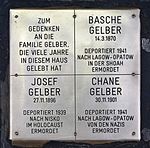
|
Basche yellow | Neubaugasse 21 |
|
May 7, 2010 | Basche Gelber was born on March 14, 1870 in Rava Ruska, Poland. She was married to Pinkas Gelber. In 1917 she came to Vienna with her family from Krakow. She had three children - Josef, Chane and Zofia. They lived in Neubaugasse 21 until 1939, they had to leave this apartment and they came to a collective apartment for Jews in Westbahnstrasse 35, also in Vienna's 7th district. Her son Josef was arrested and deported as early as 1939. On March 12, 1941, Basche and her daughter Chane were also arrested and deported with Transport 5 from Vienna to Lagow or Opatow (their number on the transport was 454). Of the 992 people who were deported on this transport, 11 survived. Basche Gelber did not survive. Her daughter Zofia was able to flee to England in 1939, her daughter Judith Gordon was present when the memorial stone was laid. Josef married Breine Eckstein in 1931, the couple had a son - Paul, born in 1932. Breine and Paul were also able to save themselves, first fled to England and then emigrated to the USA. |
| Chane Gelber | Chane Gelber was born on November 30, 1901 in Romanovka, Poland. In 1917 she came to Vienna with her family from Krakow. Here she works as a masseuse. They lived in Neubaugasse 21 until 1939, they had to leave this apartment and they came to a collective apartment for Jews at Westbahnstraße 35, also in Vienna's 7th district. Her brother Josef was arrested and deported as early as 1939. On March 12, 1941, she and her mother were arrested and deported on Transport 5 from Vienna to Lagow or Opatow (her number on the transport was 455). Of the 992 people who were deported on this transport, 11 survived. Chane Gelber did not survive. Her sister Zofia was able to flee to England in 1939, her daughter Judith Gordon was present when the memorial stone was laid. Her brother Josef married Breine Eckstein in 1931, the couple had a son - Paul, born in 1932. Breine and Paul were also able to save themselves, first fled to England and then emigrated to the USA. | ||||
| Josef Gelber | Josef Gelber was born on November 27, 1896 in Leopoldowka, Poland. In 1917 he came to Vienna with his family from Cracow, where he ran a perfumery. In 1931 he married Breine Eckstein and their son Paul was born in 1932. On October 20, 1939, he was deported from Vienna Aspangbahnhof to Nisko on the very first deportation train to leave Vienna . Only men were deported because a so-called Jewish reservation was to be built in Nisko and workers were needed. The train reached Nisko on October 23. This transport was followed by another one from Vienna on October 27, but only a small number of those deported from Vienna, 150 men, were selected for the camp. The majority were chased across the Soviet demarcation line by blank firing. Most of them were classified as politically unreliable by the NKVD and taken to forced labor camps. By 1957, a little more than 100 men had returned to Vienna from these camps. In 1940 the camp in Nisko was closed, the few men (including 198 from Vienna) were allowed to return home, but were later mostly deported again. Josef Gelber was not one of the few survivors of these two transports. | ||||
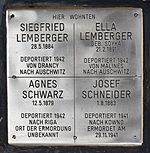
|
Ella Lemberger (née Soyka) |
Neubaugasse 23 |
|
Oct 30, 2009 | Ella Lemberger, née Soyka, was born in Vienna on February 21, 1891. She was married to Siegfried Lemberger , a film producer. The couple had two children - Gertrud (born 1914) and Edith. After the annexation of Austria , Ella and Siegfried sold the last of their belongings and they fled to Belgium. There both were separated, Ella was taken to the SS assembly camp in Mechelen . On September 8, 1942, she was deported from here to Auschwitz-Birkenau (her number on the transport was 620), where she was murdered on arrival on September 10, 1942. Her daughters Edith and Gertrud were able to flee in time, Gertrud fled via Italy to Argentina as early as 1939 and became the mother of two sons. |
| Siegfried Lemberger | Siegfried Lemberger was born on May 28, 1884 in Preßburg . He was married to Ella, née Soyka. The couple had two children - Gertrud (born 1914) and Edith. He was the tenant of the Gloriette cinema in Vienna and from 1921 he was active in the Austrian film industry. In 1937 he produced the film Der Pfarrer von Kirchfeld , a film in which, despite the agreement in place with Germany on April 20, 1936, which forbids the employment of non-Aryans , mainly Jewish artists were employed. After Austria's annexation , Siegfried and Ella sold the last of their belongings and they fled to Belgium. There both were separated. Ella has already been arrested in Denmark, Siegfried made it to France and wrote to his wife, but was also arrested, he was taken to the internment camp in Noé and the Camp de Gurs ( Relico has records that packages for him have been sent to both camps were) and is finally deported from the Drancy assembly camp on August 28, 1942 with Transport 25, Train 901-20 to Auschwitz-Birkenau , where he was murdered. | ||||
| Josef Schneider | Josef Schneider was born on August 1, 1883. In Vienna he last lived at Neubaugasse 23. On November 23, 1941, he was deported from Vienna to Kowno on transport 11, train Da 29 (his number on the transport was 128). Originally this transport should have gone to Riga, but ended on November 26th in Kovno . Those deported here had to walk six kilometers to the IX. Fort march here every 1000 people transportation to be shot between 26 and 29 November, Josef Schneider is one of those who have died on 29 November 1941st | ||||
| Agnes Schwarz | Agnes Schwarz was born on May 12, 1879. In Vienna, she last lived at Neubaugasse 23 in Vienna's 7th district. On January 26, 1942, she was deported from Vienna Aspang train station to Riga on Transport 15 (her number on the transport was 210). A total of 1200 people were in this transport. The train reached Riga on January 31, 1942. During the 6-day journey there was neither food nor water, and some of them froze to death. After arrival, people had to walk into the ghetto, whoever could no longer walk (this mainly affected the elderly and children) was offered the opportunity to ride in a car, but they never reached the ghetto, they were mobile gas vans. From transport 15, 36 people survived, Agnes Schwarz was not one of the survivors. | ||||

|
Josef Green | Neubaugasse 23 |
|
Jun 25, 2012 | Josef Grün was born on December 8, 1873 in Bur (St. Georgen). He was married to Netti Grün, the couple had a son - Paul. The family lived at Neubaugasse 23. On November 23, 1941, he and his family were deported from Vienna to Kowno on Transport 11, Zug Da 29 (his number on the transport was 997). Originally this transport should have gone to Riga, but ended on November 26th in Kovno . Those deported here had to walk six kilometers to the IX. Fort march here every 1000 people transportation to be shot between 26 and 29 November, Joseph Green is one of those who have died on 29 November 1941st |
| Netti Grün (born?) |
Netti Grün was born on September 18, 1884. She was married to Josef Grün, the couple had a son - Paul. The family lived at Neubaugasse 23. On November 23, 1941, she and her family were deported from Vienna to Kowno on Transport 11, Zug Da 29 (their number on the transport was 998). Originally this transport should have gone to Riga, but ended on November 26th in Kovno. Those deported here had to walk six kilometers to the IX. Fort march here every 1000 people transportation to be shot between 26 and 29 November, Netti Green is one of those who have died on 29 November 1941st | ||||
| Paul Green | Paul Grün was born on April 4, 1912 in Vienna. His parents were Josef and Netti Grün. The family lived at Neubaugasse 23. On November 23, 1941, he and his parents were deported from Vienna to Kowno on transport 11, train Da 29 (their number on the transport was 999). Originally this transport should have gone to Riga, but ended on November 26th in Kovno. Those deported here had to walk six kilometers to the IX. Fort march, here are between 26 and 29 November 1000 all the people of the Transportes shot Paul Green is assassinated along with his parents on 29 November 1941st | ||||
| Sali Goldberg | Sali Goldberg was born on November 3, 1875 in Kobersdorf. In Vienna he lived at Neubaugasse 23 until his deportation. On October 15, 1941, he was deported from Vienna to Łódź on transport 6, train Da 1 (his number on the transport was 406). The train reached Radegast station on October 16 October 1941. His further fate is unknown, but most of the people on this transport were murdered between May 4th and 5th, 1942 in the Chelmno extermination camp . | ||||

|
Wilhelm Eisenschimel | Neubaugasse 36 |
|
Jun 25, 2012 | Dr. Wilhelm Eisenschimel was born on September 5, 1876 in Liberec. In Vienna he last lived at Neubaugasse 36. On November 28, 1941, he was deported from Vienna to the Minsk Ghetto on Transport 12 (his number on the transport was 12). He didn't survive. |
| Marcell Singer | Marcell Singer was born in Vienna on January 7, 1903. He was married and lived with his wife Sabine, nee Klappholz, at Neubaugasse 36. On October 15, 1941, he and his wife were deported from Vienna to Łódź by transport 6, train Da 1 (his number on the transport was 991 ), the train reached Radegast station on October 16, 1941. Its further fate is unknown, but most of the people on this transport were murdered between May 4 and 5, 1942 in the Chelmno extermination camp . | ||||
| Sabine Singer (née Klapholz) |
Sabine Singer, née Klapholz, was born on December 28, 1901 in Vienna. She was married and lived with her husband Marcell at Neubaugasse 36. On October 15, 1941, she and her husband were deported from Vienna to Łódź on Transport 6, Zug Da 1 (her number on the transport was 990), the The train reached Radegast station on October 16, 1941. Their further fate is unknown, but most of the people on this transport were murdered between May 4 and 5, 1942 in the Chelmno extermination camp . | ||||

|
THIS HOUSE WAS |
Neubaugasse 36 |
|
Jun 25, 2012 | Text follows |
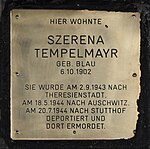
|
Szerena Tempelmayr (née Blau) |
New building belt 18 |
|
Jun 3, 2014 | Szerena Tempelmayr, nee Blau, was born on October 6, 1902 in Bratislava . The last time she lived in Vienna was Neubaugürtel 13. She was deported on September 2, 1943 with transport 46k (her number on the transport was 934) from Vienna to the Theresienstadt ghetto (in the ghetto records the transport is referred to as IV / 14l, the Roman IV stands for arrival from Vienna). On May 18, 1944, she was transferred to the Auschwitz-Birkenau concentration camp on Transport Eb (her number on the transport was 1999) and finally on July 20, 1944, she was transferred to the Stutthof concentration camp , where she was murdered. |

|
IN MEMORY OF ALL |
Volkstheater (Neustiftgasse side) |
|
unknown | Immediately after the annexation of Austria in March 1938, which was des Deutschen Volkstheater dissolved, the assets flowed partly into the party coffers of the NSDAP and the property was the German Labor Front on suitable. Orders from the Reich Propaganda Minister immediately shaped the game plans; Jewish, politically and artistically unpopular artists were immediately removed, driven into emigration or later deported and murdered in the East. Goebbels' maxims for all theaters in his domain comprised four points:
The following ensemble members and guests of the Volkstheater were forced into emigration by the Nazi regime or deported to concentration camps and murdered:
Rosenthal was murdered in Auschwitz, Forest as part of the so-called euthanasia procedure with an air injection in Vienna. Csokor and the famous actress Tilla Durieux (1880–1971), who had often appeared at the Volkstheater, joined the resistance movement in Yugoslavia. Schönauer was able to survive in Vienna - banned from working - Grieg found engagements in Mährisch-Ostrau and later in Metz. The actor Franz Feldmann disappeared without a trace, the former director Rudolf Beer (1885–1938) committed suicide after being badly mistreated by Nazi thugs. |
swell
- Stones of Remembrance : Projects in Vienna's districts 14 to 19 , accessed several times from September to December 2015
- Documentation archive of the Austrian resistance : database of victims , accessed several times from September to December 2015
- A Letter To The Stars : Murdered , accessed several times from September to December 2015
- Yad Vashem's database , accessed several times from September to December 2015
- Holocaust.cz database (German, English, Czech), accessed several times from September to December 2015
- Brochures accompanying the memorial stones with biographies published by the " Stones of Memory " association
Individual evidence
- ↑ Seeber, Ursula, Mayr, Brigitte, Omasta, Michael. Westend Stories: Memories and Texts from Vienna VII. 2009, 7–9
- ^ Claims Resolution Tribunal: In re Holocaust Victim Assets Litigation Case No. CV96-4849 , accessed December 31, 2015
- ^ Claims Resolution Tribunal: In re Holocaust Victim Assets Litigation Case No. CV96-4849 , accessed December 31, 2015
- ↑ Irene Löwy: Cultural Policy in National Socialism 1938 to 1945 using the example of the German People's Theater in Vienna , diploma thesis at the University of Vienna, November 2010 (in this work numerous misspellings of proper names)
Web links
- Stones of Remembrance , official website

